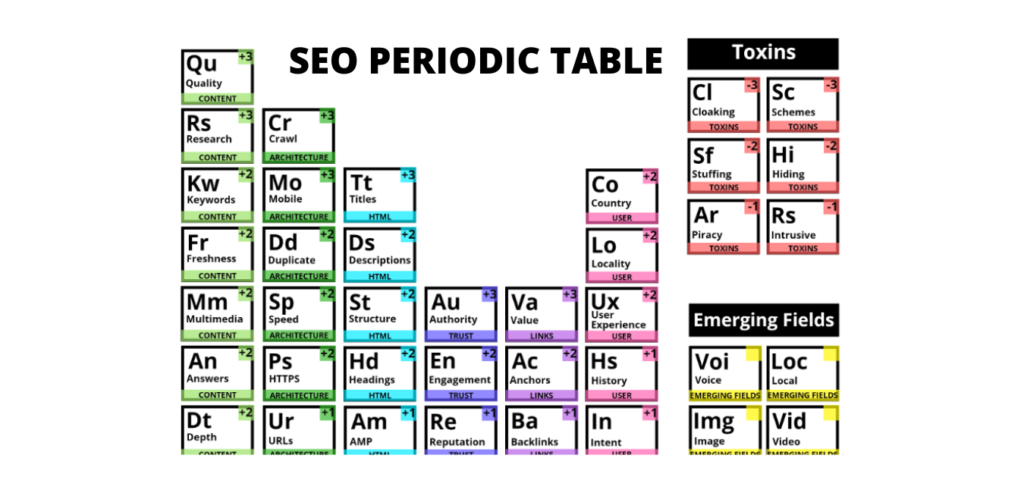
SEO Periodic Table is a valuable tool for understanding the key elements of search engine optimization (SEO). It simplifies the complex world of SEO by breaking it down into fundamental components, much like how the periodic table organizes elements in chemistry. This guide will walk you through each section of the SEO Periodic Table, explaining its importance and how you can use these elements to improve your website’s search engine ranking.
1. On-Page SEO
On-page SEO refers to the elements you control on your own website to improve its search engine ranking. These are some of the critical components:
- Title Tags: This is the title that appears in search engine results. Use clear, descriptive titles with relevant keywords to help both users and search engines understand the content of your page.
- Meta Descriptions: Meta descriptions are short summaries of your page content. Although they don’t directly impact rankings, a compelling meta description can improve your click-through rate.
- Headings: Use headings (H1, H2, H3, etc.) to structure your content. This helps search engines and users easily navigate your content. Make sure to include keywords naturally in these headings.
- URL Structure: A clean and descriptive URL helps search engines understand your page’s content. Use keywords in your URLs and avoid long, complex strings.
- Content: Quality content is crucial for SEO. Write informative, engaging, and original content that addresses the needs of your target audience.
- Keyword Usage: Integrate keywords naturally into your content. Overuse can lead to keyword stuffing, which can harm your rankings.
- Internal Linking: Link to other relevant pages on your site. This helps search engines understand the structure of your site and keeps users engaged longer.
- Image Optimization: Use descriptive file names and alt text for images. This helps search engines understand what the images are about and can drive traffic through image search.
- Mobile Friendliness: Ensure your site is mobile-friendly. Google prioritizes mobile-first indexing, so a responsive design is essential.
- Page Speed: Fast-loading pages provide a better user experience and can improve your rankings. Optimize images and use efficient coding practices to speed up your site.
2. Off-Page SEO
Off-page SEO involves activities outside your website that can impact your search engine ranking. Here are some important aspects:
- Backlinks: Obtain high-quality backlinks from reputable sites. These act as endorsements of your content and can significantly impact your search rankings.
- Social Signals: Social media activity can drive traffic to your site and generate brand awareness. While not a direct ranking factor, a strong social presence can complement your SEO efforts.
- Brand Mentions: Even if a site doesn’t link back to you, mentions of your brand can signal credibility to search engines. Build relationships and get mentioned in relevant, authoritative sources.
- Local SEO: For local businesses, optimize your site for local searches. Claim your Google My Business listing and ensure your business information is accurate and consistent across the web.
3. Technical SEO
Technical SEO focuses on the backend elements of your site that affect search engine crawling and indexing. Key components include:
- XML Sitemap: An XML sitemap helps search engines discover and index your pages. Make sure it’s updated regularly and submitted to search engines.
- Robots.txt: This file guides search engine crawlers on which pages to crawl and which to avoid. Ensure it’s correctly configured to prevent blocking important pages.
- Structured Data: Implement structured data (Schema.org) to help search engines understand the content of your pages better and enhance search results with rich snippets.
- HTTPS: Secure your site with HTTPS. Google considers HTTPS a ranking factor, and it ensures that user data is encrypted and protected.
- Canonical Tags: Use canonical tags to prevent duplicate content issues. These tags tell search engines which version of a page is the “main” one.
4. User Experience (UX)
User experience plays a crucial role in SEO. Google’s algorithms increasingly prioritize user satisfaction. Consider these elements:
- Navigation: Design intuitive navigation to help users find what they’re looking for easily. A well-structured site keeps users engaged and reduces bounce rates.
- Readability: Ensure your content is easy to read. Use short paragraphs, bullet points, and clear language to make your content accessible.
- Engagement: Encourage user interaction through calls-to-action, comments, and social sharing options. Engaged users are more likely to spend time on your site and return.
5. Analytics and Reporting
Track your SEO performance to understand what’s working and what needs improvement. Key tools include:
- Google Analytics: Monitor traffic, user behavior, and other key metrics to gauge your SEO effectiveness.
- Google Search Console: Track your site’s performance in search results, identify issues, and gain insights into your search traffic.
- SEO Tools: Use tools like SEMrush, Ahrefs, or Moz to analyze backlinks, keywords, and other critical factors.
Conclusion
The SEO Periodic Table breaks down the complex world of search engine optimization into manageable elements. By focusing on on-page SEO, off-page SEO, technical SEO, user experience, and analytics, you can create a comprehensive strategy to improve your website’s visibility and ranking. Understanding and implementing these key components will help you build a strong SEO foundation and drive more traffic to your site.